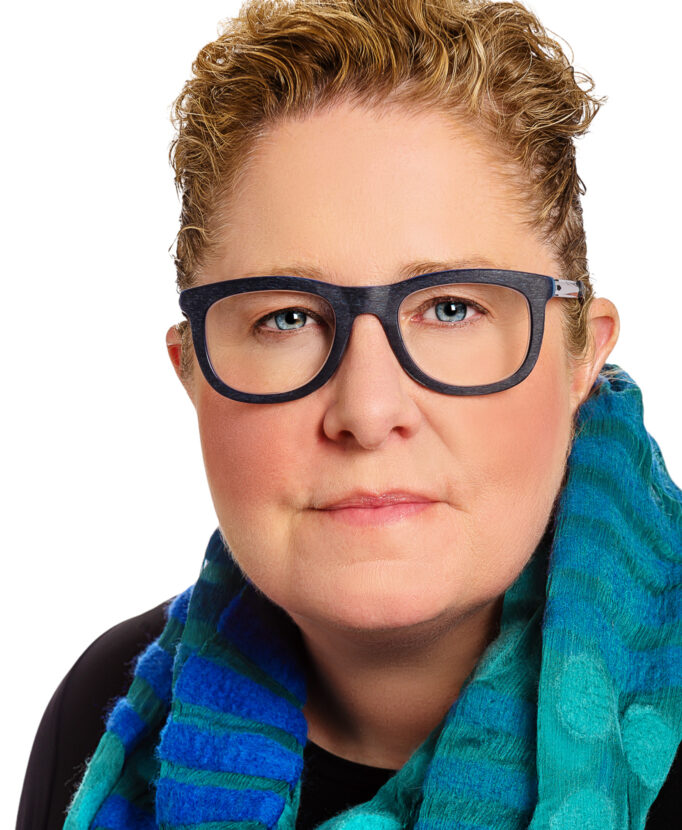Deep Dive
Leading the Empowered Workforce
Heather McGowan explains how the pandemic accelerated the velocity of change and ushered in two profound transitions: a revolution in the relationship between individuals and organizations, and the digital disruption that has transformed organizations from linear to complex.

The Pandemic Removed the Factory Default Settings for Work
Psychiatrists say it takes 66 days to form a habit. Over 900 days ago, the World Health Organization declared a global pandemic. Suffice to say, we have formed some habits, and we are not going back to the pre-pandemic days of 2019.
As we enter the post-pandemic phase, we should first acknowledge that we exceeded many expectations we might have developed at the beginning of COVID. If someone had told you in Fall 2019 that by March 25, 2020,more than 3 billion people across 70 countries would be sent to work from home on a full-time basis, would you have believed them? Would you have believed that so much change could occur with a relatively nominal loss of business continuity? Could you have accepted that the resulting uncertainty would stretch into a third year?
The prolonged, forced social experiment set in place by the COVID pandemic removed many of our factory default settings of work. With these default settings removed, we can institute the most profound changes to work since the first industrial revolution. To capitalize on this opportunity, we must acknowledge a few simultaneous and monumental changes. First, the relationship between individuals and organizations has been forever altered. Second, because our workplace structures and processes were not crafted for the reality of our workforce, and our workforce – who are your customers – are not unified by any one age, race, gender, gender identity, sexuality, political view, religion, cognition, we can harness this rich diversity, which in fact, is essential for your ongoing success. And third, with the impact of fifteen years of digitization and exponential growth in technology, businesses have been transformed from linear to complex and many are seeing a rapid shift of their core identity. The culmination of these transformations demands a fundamental re-imagination of work itself and redefined profiles for those who lead it.
The Changed Relationship Between Individuals and Organizations
The first transformation is in the agreement that has existed between individuals and organizations. Where employees once traded loyalty for security, to then offering energy and productivity in exchange for career development, staff now seek to partner with their organization and their leaders in formulating shared purpose and work-life balance. The pandemic caused an existential crisis where many individuals question why they work and, more profoundly, where work fits in their lives. What has been dubbed the Great Resignation, by Professor Anthony Klotz of UCL School of Management in London is really a similar outcome with a multiplicity of factors. I think of the Great Resignation as having 5 distinct “Great” aspects:
- The Great Resignation – Churn has been building since 2009, and Gartner predicts it will increase 20% going forward. Talent is mobile.
- The Great Retirement – The silver tsunami of retiring boomers has begun. Labor Shortages will continue unabated.
- The Great Reshuffle – The labor market is reordering as staff reskill to change jobs and industries. Humans are working to their potential.
- The Great Refusal – Staff are resisting employment where they are underpaid, unsafe, stretched beyond their job description (consider the pushback under “Quiet Quitting”), or conditions are otherwise unacceptable. Humans are assets to develop, not costs to contain.
- The Great Relocation – Hybrid and remote work becomes a norm. We are seeing settlement patterns change. Talent is shifting their priorities from work-life to life-work balance.
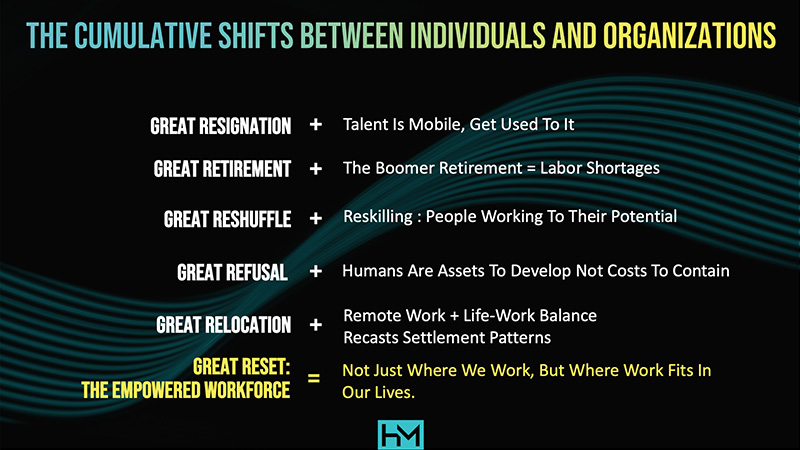
Collectively, this gives us what I call “The Great Reset” – the actions of an empowered workforce that is not going back to pre-pandemic 2019 regardless of the state of our economy. This workforce has had 900+ days to taste autonomy, to contemplate their purpose, to search for, and even demand, meaningful work, and to express their changing expectations in how and when they engage with organizations. After decades of declining engagement and rising levels of burnout, this workforce is empowered and seeks to be engaged. If handled skillfully, this transformation could lead to new levels of engagement and self-expression, ultimately unleashing more human potential. It would benefit not only staff and organization—but ultimately I believe investors as well.
Meet Your Empowered Workforce: Diverse, Empowered, Values-Driven
Depending on where in the world you live and work, you may be experiencing youth booms, notably in the Middle East, Africa, and India, or an aging society, noticeably in the United States, Canada, Asia, and Europe. This means some parts of the world are experiencing labor shortages while others experience labor surpluses and high youth unemployment.
In the U.S., according to the 2020 census, there is not a racial majority in the 18-and-under demographic. In other words, in the U.S., the racially diverse workforce is not coming; it is here. Gen Z is entering the workforce, and LinkedIn data shows they will be 30% of the workforce by 2030, which means they will be the most consequential generation in the past 100 years. Gen Z is our first digitally native generation and the first born after 9/11, with terrorism and mass school shootings as a norm. When Gen Z’ers were in middle school, in 2018, the United Nations climate report declared that we had 12 years to save the planet. They come to age experiencing everything from the tragic death of George Floyd, to the Black Lives Matter and #metoo movements. Many of them do not adhere to binary definitions of gender or sexuality. Work is a means of self-expression for them and 80% insist it aligns with their values and purpose.
This has an effect on business: research by the Wall Street Journal found the twenty most diverse S&P 500 companies outperformed non-diverse companies over the past five- and ten-year periods. This leads investors to realize that the inside of companies, and most notably the leadership, should look like the markets they serve and are demanding greater diversity of executive teams and real action on DEI (Diversity, Equity, and Inclusion) initiatives. I believe and find from my talks with various corporations that it’s imperative to add belonging to the DEI work and mindset. Diversity is representation; equity is fairness, and inclusion is action- but belonging is the feeling. If people working for you do not feel seen and accepted, they will withdraw and not contribute, resulting in a loss of human potential. Leading a diverse workforce requires establishing psychological safety, a sense of being integral and included, and not feeling like the “Other” in your workplace.
Shift from Linear to Complex
When work was linear, routine, and consistent, the velocity of change was much slower. As a result, we could hire unquestioned experts who could drive productivity with process and sometimes fear and make decisions with certainty. We could also hire trained people ready to execute known tasks with predetermined knowledge. As a result, humans could be treated as costs to contain; as fungible and depersonalized units of productivity. Treating humans as a depersonalized cost to contain was never motivating, and the notion of an unquestioned expert as supervisor and boss was never a good idea; however, with today’s velocity of change, these notions are truly liabilities. Most leaders today are directing teams of people, many of whom have skills and knowledge they do not have. This requires a profound rethinking of the leadership profile.
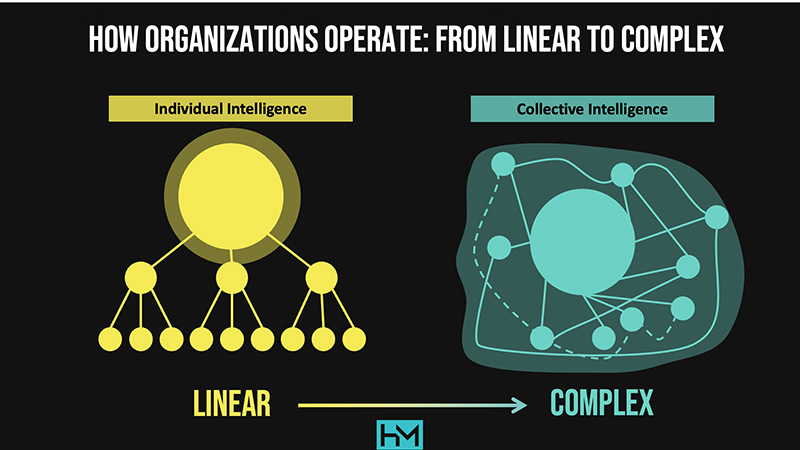
Industries Rapidly Transform: Learning is Part of Work
Fifteen years of digital disruption has enabled some organizations to pivot their core identity, especially when their product or service derives from culling insights from data. Josh Bersin posits about the convergence and transformation of industries, where he argues – and I agree with him: “This is a rapid change in demand, accelerated by the pandemic and fifteen years of digital disruption. So rather than just “lay people off” (of course some tech companies did vastly over hire), you need to “redeploy” your people into these new industry roles.” Bersin argues we need to move beyond the spill-and-fill model of lunging at talent to an approach that recruits for new capabilities and reskills, redesigns jobs, and focuses on retaining staff and workers to reinvest in them as the industries they work in morph and change. Learning is now, unequivocally, an integral part of work.
Human Development is the New Goal of Organizations
In the Milton Friedman Shareholder Value Era, the purpose of a business was a myopic focus on returning profits to shareholders. Full stop. That Shareholder Value Era reigned until 2019 when the Business Roundtable redefined the purpose of a company thus: “Companies should serve not only their shareholders but also deliver value to their customers, invest in employees, deal fairly with suppliers and support the communities in which they operate.” Further, a recalculation by Ocean Tomo of the enterprise value of all the companies on the S&P 500 at that time, in 1975, shows that 83% of the value was derived from tangible assets (property, plant, and equipment) and 17% from intangible assets (patents, ideas, human ingenuity). In 2020 that equation flipped entirely with 90% of the value coming from intangible and 10% from tangible assets. As a result, the focal point shifts to developing human potential as the purpose of the company and value creation as a byproduct of that endeavor. It may seem to diminish a target on value but, instead, it sharpens that focus by intentionally developing the source of value creation.
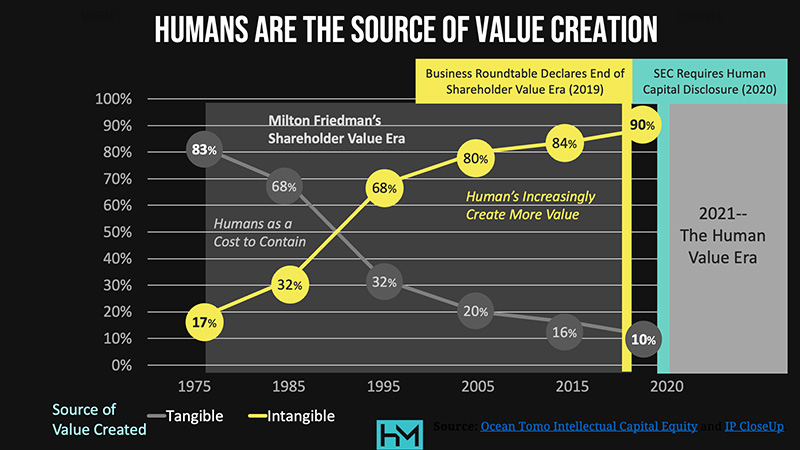
Required Leadership Transformation
The culmination of these transformations – a diverse, empowered workforce encountering more complex work within rapidly shifting industries, along with a new focus on developing human potential – requires a fundamental rethinking of leadership. I see this leadership transformation requiring four fundamental shifts:
- Mindset: from managing people to enabling success
- Culture: from peers as competitors to peers as collaborators
- Approach: from extrinsic pressure to intrinsic motivation
- Behavior: from driving productivity through fear to effectiveness through inspiration
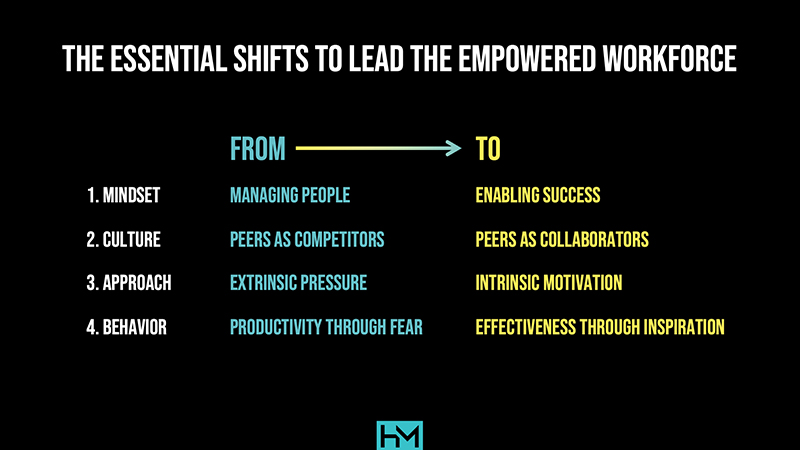
Of course, factors outside of business will act as catalysts to these shifts. Given the speed at which technology will consume the routine and predictable tasks, coupled with a rise in uncertainty from climate events, geopolitical events, social unrest, future pandemics, economic events, and market changes, we need leaders who can guide expeditions and harness collective intelligence. This mindset shift flips the notion of talent as working for you, to you working for talent to enable their success. For this to be rewarding you cannot be managing conflict among your team; you need your team members to problem solve and collaborate. This is a cultural shift that prioritizes collaboration.
We will never be able to learn and adapt at the speed, scale, and scope required by the rate of change. As such, we need to shift from motivating with rewards and responding with punishments, towards inspiring through guiding talent towards their own internal drive to become, what I call, self-propelled. Finally, we need leaders who are not unquestioned experts driving productivity with reward and fear, but instead who are competent, caring, humble, and curious learners who can say “I don’t know,” who can model vulnerability and demonstrate empathy, and who can coach and champion everyone to achieve their highest potential.
I am profoundly optimistic about the opportunity that stands in front of us to reimagine talent and leadership for more of us. This is our call to action. Let’s go.
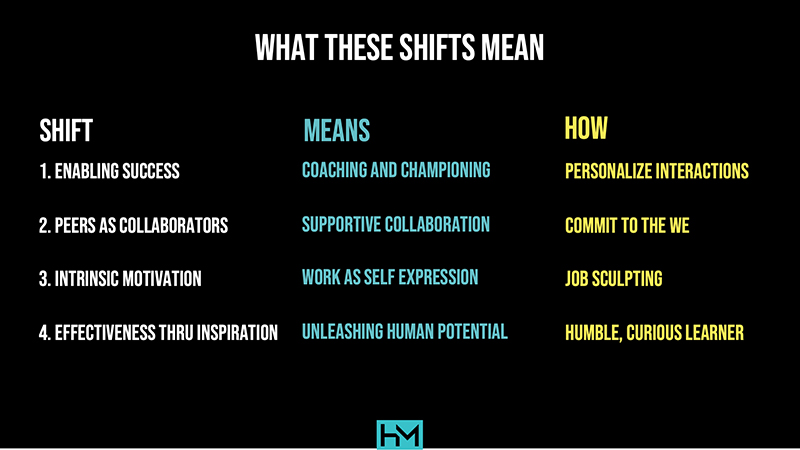
Events aren’t easy, but working with WSB is. WSB works with thousands of respected influencers, thought leaders, and speakers each year and our experienced sales team is committed to the success of your event. For more futurist speaker ideas, please contact us.
